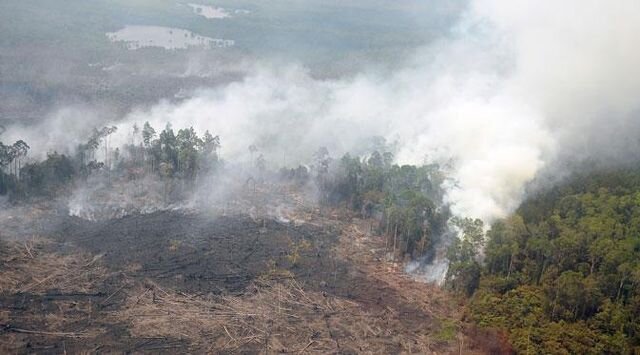Forest Fires in Indonesia – A Predictable Disaster
On October 27, 2015, Indonesia experienced a sudden and extraordinary downpour of rain in the Kalimantan and the Sumatra Provinces. It was a welcome blessing for many Indonesians since the annual rainy season was delayed due to the El Niño effect that year. El Niño had caused an exceptionally long dry season which resulted in disastrous forest fires throughout both provinces. Since July 2015 there were at least 100,000 forest fires in Indonesia, which pushed total air pollution levels in the direction of 2,000 PSI (“Pollutant Standard Index”) units. This amount is far above 300 PSI units, the level at which it becomes extremely hazardous to human health.
In October 2015, governors of six provinces declared states of emergency and requested assistance from the Indonesian central government. President Joko Widodo (commonly known as Jokowi) of Indonesia shortened his official trip to the United States to return to his country and preside over emergency relief. For many conservationists, the forest fires were not a surprise. There have been concerns about the deliberate forest fire practices used by Indonesian farmers. These fires that caused a national emergency in Indonesia were a man-made disaster. They started as controlled fires used by farmers to clear land, but due to a lack of preparation and failure to heed weather forecast warnings, the situation escalated to an international crisis. The 2015 fire disaster could have been prevented if the government had been tougher on the practice of clearing land with fire and had appropriately informed farmers of the weather pattern. The Indonesian government must take these steps in the future to prevent such events from recurring.
As Indonesia enters the global market and faces higher demand for export goods, rapidly increased agricultural output is essential to meet the demand for commodities. Most of the world’s palm oil comes from Indonesia.1 In 2012, designated palm oil farms accounted for 30,000 square kilometers of Borneo Island.2 This reflects a 1,500 percent upsurge of designated land for palm oil farming since 1967.3 Every year, after the fruits of the trees are ripened, farmers burn the harvested palm trees to clear the land. Many of these fires are often ignited on carbon-rich peatlands. In peatlands, the fires burn into the earth, sometimes blazing for months underground and on the surface during dry seasons. As a result of these practices, Indonesia ranks as the third largest polluter in terms of greenhouse carbon emissions, following the United States and China. Some researchers suggest that from July until October in 2015 alone, Indonesia surpassed Germany’s carbon emission rate for an entire year.
While the long-term impact on citizens is mostly unknown, many scientists are concerned about the related illnesses that can arise from fine particulate matter (PM2.5) emitted into the air.4 Particulate matter is linked with pulmonary illnesses, cardiovascular disease and premature deaths. According to a paper published in Nature’s Climate Change Journal, in the years when the El Niño weather pattern occurred in Southeast Asia, there were elevated amounts of particulate matter which lead to an annual increase of 10,800 deaths from cardiovascular diseases. In October 2015, there were 500,000 identified cases of respiratory tract infections and 19 confirmed deaths from respiratory complications. Additionally, there were estimates suggesting that more than 100,000 premature deaths could be caused due to forest fires in coming years. The toxic fumes from the fires have already affected nearly 43 million residents of Sumatra and Kalimantan. The Indonesian government estimates that the economic loss from these fires could be at least $47 billion.
There is plenty of blame to go around, from the local and central governments to the big corporations who turned a blind eye on poor farming practices. These corporations continued purchasing raw materials from Indonesian farmers, despite the widespread loss of forest from runaway fires. However, the underlying problem is that farming is a way of making ends meet for many citizens in Indonesia, making any restriction of it politically unpopular.5 Since palm oil is used in 50 percent of all consumer products such as soaps, cereals and vegetable oils, demand for it is incredibly high.6 As a billion dollar industry in Indonesia, it will be quite difficult to change.7
The forest fires in Indonesia would have been an even bigger disaster were it not for the monsoon rains in November 2015. The risk was well understood from the beginning, but it was ignored because the Indonesian economy depends heavily on palm tree farming and corporations chose monetary gains over the environment and human health. The El Niño weather patterns could have allowed the government and farmers to predict this disaster. Thus, they could have taken proactive measures to reduce the risk of fires burning uncontrollably.
The use of large commercial forest burning is illegal in Indonesia, although enforcement of this prohibition is weak. Jokowi’s administration must start forcefully cracking down on perpetrators. Furthermore, the government must educate poor farmers about the environmental harms caused by commercial forest burning and create a sustainable alternative to commercial forest burning to aid the industry. The government should also allot plantation areas diligently rather than using the free-for-all system that exists, involve conservationists and farmers to plan land use in order to preserve forests and ecological sites, and prohibit palm plantations grown on the peatlands. In addition, international buyers of palm oil must take responsibility for improving the standards of palm oil production.
The environmental impact of these fires has been catastrophic and will take decades to redress. However, the social and economic impacts caused by the forest fires should change the attitude of the public and government in coming years. Anything short of this needed change will be a travesty.
